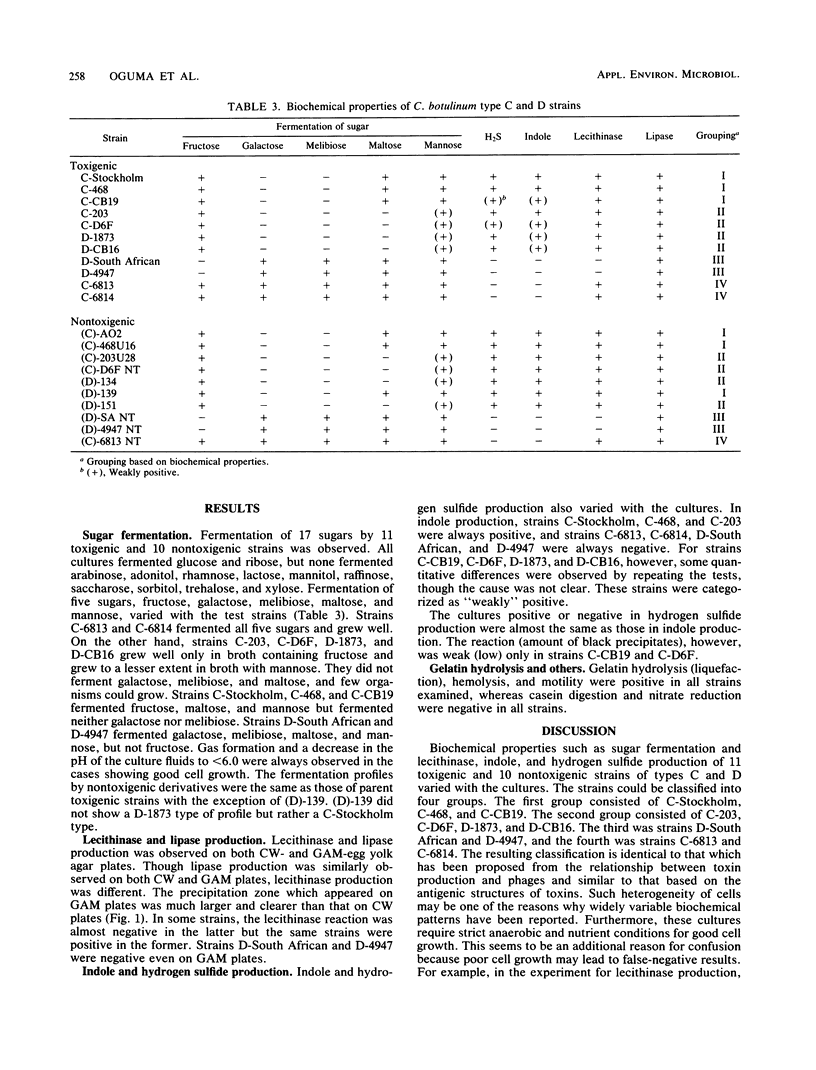Abstract
The biochemical properties of 11 toxigenic and 10 nontoxigenic type C and D strains of Clostridium botulinum were studied. All of the strains examined were motile and hemolytic and produced lipase and liquid gelatin. Fermentation of several sugars and the production of lecithinase, indole, and hydrogen sulfide varied with the strain. The strains were classified into four groups based on their sugar fermentation profiles. The resulting classification was identical to the classification which had been proposed from the relationship between toxin production and phages and similar to the grouping based on the nature of toxin antigenic structures. Lecithinase production was negative in the cells belonging to group III, and indole and hydrogen sulfide production was negative in the cells of groups III and IV. Strains belonging to groups III and IV have many characteristics different from those of groups I and II.
Full text
PDF




Images in this article
Selected References
These references are in PubMed. This may not be the complete list of references from this article.
- Eklund M. W., Poysky F. T., Reed S. M. Bacteriophage and the toxigenicity of Clostridium botulinum type D. Nat New Biol. 1972 Jan 5;235(53):16–17. doi: 10.1038/newbio235016a0. [DOI] [PubMed] [Google Scholar]
- Eklund M. W., Poysky F. T., Reed S. M., Smith C. A. Bacteriophage and the toxigenicity of Clostridium botulinum type C. Science. 1971 Apr 30;172(3982):480–482. doi: 10.1126/science.172.3982.480. [DOI] [PubMed] [Google Scholar]
- Hobbs G., Stiebrs A., Eklund M. W. Egg yolk reaction of Clostridium botulinum type E in different basal media. J Bacteriol. 1967 Mar;93(3):1192–1192. doi: 10.1128/jb.93.3.1192-.1967. [DOI] [PMC free article] [PubMed] [Google Scholar]
- Inoue K., Iida H. Conversion of toxigenicity in Clostridium botulinum type C. Jpn J Microbiol. 1970 Jan;14(1):87–89. doi: 10.1111/j.1348-0421.1970.tb00495.x. [DOI] [PubMed] [Google Scholar]
- Inoue K., Iida H. Phage-conversion of toxigenicity in Clostridium botulinum types C and D. Jpn J Med Sci Biol. 1971 Feb;24(1):53–56. [PubMed] [Google Scholar]
- Jansen B. C. The toxic antigenic factors produced by Clostridium botulinum types C and D. Onderstepoort J Vet Res. 1971 Jun;38(2):93–98. [PubMed] [Google Scholar]
- Nakamura S., Kimura I., Yamakawa K., Nishida S. Taxonomic relationships among Clostridium novyi Types A and B, Clostridium haemolyticum and Clostridium botulinum type C. J Gen Microbiol. 1983 May;129(5):1473–1479. doi: 10.1099/00221287-129-5-1473. [DOI] [PubMed] [Google Scholar]
- Ochanda J. O., Syuto B., Oguma K., Iida H., Kubo S. Comparison of antigenicity of toxins produced by Clostridium botulinum type C and D strains. Appl Environ Microbiol. 1984 Jun;47(6):1319–1322. doi: 10.1128/aem.47.6.1319-1322.1984. [DOI] [PMC free article] [PubMed] [Google Scholar]
- Oguma K., Agui T., Syuto B., Kimura K., Iida H., Kubo S. Four different monoclonal antibodies against type C1 toxin of Clostridium botulinum. Infect Immun. 1982 Oct;38(1):14–20. doi: 10.1128/iai.38.1.14-20.1982. [DOI] [PMC free article] [PubMed] [Google Scholar]
- Oguma K., Murayama S., Syuto B., Iida H., Kubo S. Analysis of antigenicity of Clostridium botulinum type C1 and D toxins by polyclonal and monoclonal antibodies. Infect Immun. 1984 Feb;43(2):584–588. doi: 10.1128/iai.43.2.584-588.1984. [DOI] [PMC free article] [PubMed] [Google Scholar]
- Oguma K., Sugiyama H. Adsorption to Clostridium botulinum cultures of phage controlling type C botulinum toxin production. Proc Soc Exp Biol Med. 1978 Oct;159(1):61–64. doi: 10.3181/00379727-159-40284. [DOI] [PubMed] [Google Scholar]
- Oguma K., Syuto B., Agui T., Iida H., Kubo S. Homogeneity and heterogeneity of toxins produced by Clostridium botulinum type C and D strains. Infect Immun. 1981 Nov;34(2):382–388. doi: 10.1128/iai.34.2.382-388.1981. [DOI] [PMC free article] [PubMed] [Google Scholar]
- Oguma K., Syuto B., Iida H., Kubo S. Antigenic similarity of toxins produced by Clostridium botulinum type C and D strains. Infect Immun. 1980 Dec;30(3):656–660. doi: 10.1128/iai.30.3.656-660.1980. [DOI] [PMC free article] [PubMed] [Google Scholar]
- Segner W. P., Schmidt C. F., Boltz J. K. Enrichment, isolation, and cultural characteristics of marine strains of Clostridium botulinum type C. Appl Microbiol. 1971 Dec;22(6):1017–1024. doi: 10.1128/am.22.6.1017-1024.1971. [DOI] [PMC free article] [PubMed] [Google Scholar]
- Segner W. P., Schmidt C. F., Boltz J. K. Minimal growth temperature, sodium chloride tolerance, pH sensitivity, and toxin production of marine and terrestrial strains of Clostridium botulinum type C. Appl Microbiol. 1971 Dec;22(6):1025–1029. doi: 10.1128/am.22.6.1025-1029.1971. [DOI] [PMC free article] [PubMed] [Google Scholar]
- Segner W. P., Schmidt C. F. Heat resistance of spores of marine and terrestrial strains of Clostridium botulinum type C. Appl Microbiol. 1971 Dec;22(6):1030–1033. doi: 10.1128/am.22.6.1030-1033.1971. [DOI] [PMC free article] [PubMed] [Google Scholar]



